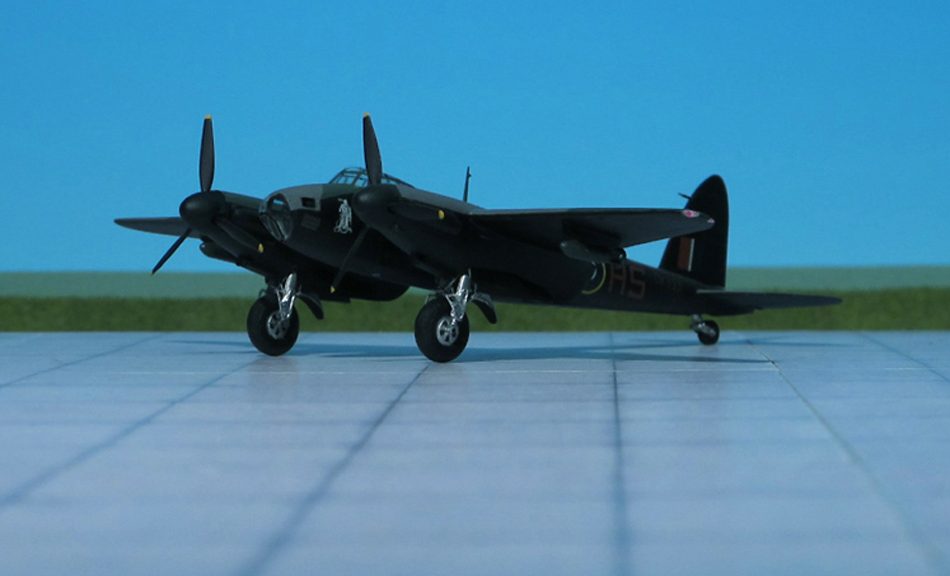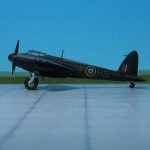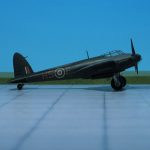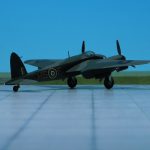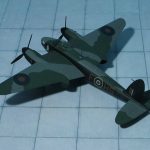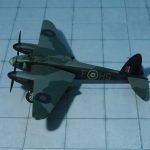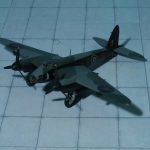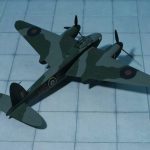TYPE: Medium-altitude tactical bomber
ACCOMMODATION: Pilot and bombardier/navigator
POWER PLANT: Two Rolls-Royce “Merlin” 76/77 liquid-cooled engine, rated at 1,710 hp each
PERFORMANCE: 361 mph at 28,000 ft
COMMENT: The de Havilland DH.98 “Mosquito” was a British multi-role combat aircraft with a two-man crew during WW II. It was one of few operational front-line aircraft of the era constructed almost entirely of wood and was nicknamed “The Wooden Wonder”. Originally conceived as an unarmed fast bomber, the “Mosquito” was adapted to roles including low to medium-altitude daytime tactical bomber, high-altitude night bomber, pathfinder, day or night fighter, fighter-bomber, intruder, maritime strike aircraft, and fast photo-reconnaissance aircraft.
When “Mosquito” production began in 1941, it was one of the fastest operational aircraft in the world. Entering widespread service in 1942, the “Mosquito” flew high-speed, medium or low-altitude missions against factories, railways and other pinpoint targets in Germany and German-occupied Europe. From late 1943, “Mosquito” bombers were formed into the Light Night Strike Force and used as pathfinders for RAF Bomber Command heavy-bomber raids. They were also used as “nuisance” bombers, often dropping “Blockbuster” bombs – “cookies” – in high-altitude, high-speed raids that German night fighters were almost powerless to intercept.
On 21 June 1941 the Air Ministry ordered that the last 10 “Mosquitoes”, ordered as photo-reconnaissance aircraft, should be converted to bombers. These 10 aircraft were part of the original 1 March 1940 production order and became the B Mk IV Series 1. The prototype flew for the first time on 8 September 1941.
The bomber prototype led to the B Mk IV, of which 273 were built: apart from the 10 Series 1s, all of the rest were built as Series 2s with extended nacelles, revised exhaust manifolds, with integrated flame dampers, and larger tail planes. Series 2 bombers also differed from the Series 1 in having a larger bomb bay to increase the payload to four 230 kg bombs. This was made possible by shortening the tail of the 230 kg bomb so that these four larger weapons could be carried. The B Mk IV entered service in May 1942.
In April 1943 it was decided to convert a B Mk IV to carry a 1,800 kg “Blockbuster” bomb (nicknamed “Cookie”). The conversion, including modified bomb bay suspension arrangements, bulged bomb bay doors and fairings, was relatively straightforward and 54 B.IVs were modified and distributed to squadrons of the Light Night Striking Force. 27 B Mk IVs were later converted for special operations with the “Highball” anti-shipping weapon
Total “Mosquito” production in all variants during WW II was 6,710 aircraft. Because the aircraft were made entirely from wood mainly furniture companies were involved in production. Fuselage shells, wing spars, special wood veneers, many of the other parts, including flaps, flap shrouds, fins, leading edge assemblies and bomb doors were also produced in High Wycombe, which was well suited to these tasks because it had a well-established furniture manufacturing industry (Ref.: 24).
